Economic activity of the population - 3 quarter
10.11.2010
Code: q-3133-10
In the first three quarters of this year there were, on average, 238 thousand persons, who were receiving pensions, working in the national economy. Overwhelming portion of them were pensioners in regular old-age retirement and including working persons in early old-age retirement these pensioners accounted for 150 thousand persons. Over 80 thousand working pensioners were receiving disability pension of all three degrees. Working pensioners thus represented overall almost 5% of all working persons and make a non-negligible portion of active labour resources.
Data of the Labour Force Sample Survey (LFSS) on the total number of pensioners receiving old-age pension or disability one are in narrow relation to the numbers of persons receiving pension according to the complete register of the Czech Social Security Administration. Because some pension recipients have not permanent residence in the Czech Republic (payments are made to foreign countries) then the difference in data on the total number of old-age pensioners and that of disability ones reaches ± 0.5%. The sample survey is therefore a sufficiently representative source to assess the level of economic activity of these persons.
Besides pensioners it is also students who affect overall employment at a certain extent. Involvement of students into working life is, however, in the absolute numbers lower than in the case of working pensioners. Their number reached on average less than 53 thousand over nine months. Activity of the students is highly seasonal. The share of both the categories of pensioners and students in the number of all working persons attains six per cent.
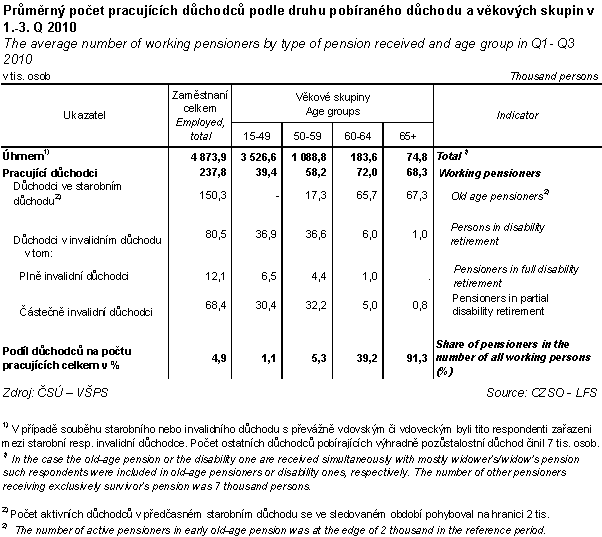
It follows from the LFSS results that the number of working females with pension is slightly higher than that of males. This is a logical consequence of a higher number of working females receiving only widow’s pension, and namely of a higher number of active females in regular old-age retirement. Working old-age female pensioners outnumber the number of working old-age male pensioners in the whole ten-year age group of 55-64 years. Intensity of involvement of males and females of this age in work is, however, substantially different. The number of working males of 55-59 years of age outnumbered the number of working females in this five-year age group by 76 thousand (M/F Index 1.35). In the age group of younger sexagenarians (60-64 years of age), there were even 2.2 times more males than females (by 69 thousand). This is clearly due to the effect of different age limits for earning retirement, which enable, especially to younger female pensioners, to work further and receive pension at the same time.
Discrepancies in the share of old-age pensioners of the total number of working persons are prominent right in the group of 60-64 years of age. While roughly one quarter (26.5%) of all persons was receiving pension of the total number of working males, females were involved into active life less frequently, yet the share of female pensioners working at this age reached two thirds of all working females (67.4%). Therefore it is characteristic for the dominating portion of males at this age that they have income solely from their work activity while majority of working females is also receiving pension.
The share of pensioners in the total number of working persons is essentially changed in the group of 65+ years of age. The number of working males significantly outnumbers the number of working female pensioners at this age. At the same time, the pensioners’ share in the number of working persons at higher age is considerable in both the sexes (in males almost 90%, in females 95%).
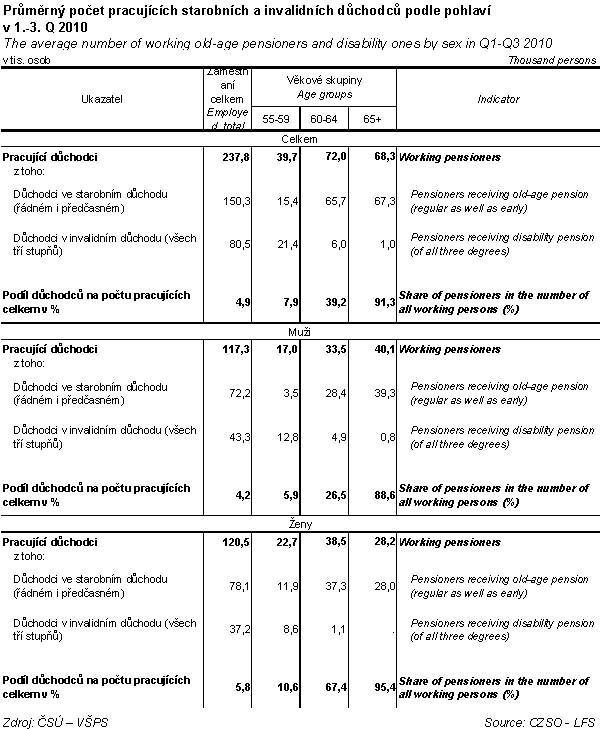
The largest group of working pensioners are pensioners receiving old-age pension, mostly regular old-age pension. Concerning the regional view the most of old-age pensioners worked in the Capital City (less than 28 thousand, i.e. almost one fifth of all working old-age pensioners in the country). Their number is more significant also in Středočeský Region and Jihomoravský Region, and their number exceeded ten thousand also in Moravskoslezský Region. These are the four most populated regions of the country and this fact is the most important one affecting the numbers given. Intensity of the old-age pensioners involvement is, however, different in respective regions.
Taking into account the share of working old-age pensioners of the total number of persons receiving the given type of pension then the highest intensity of pensioners’ involvement in work is again in Prague, where every tenth old-age pensioner, having residence on the Capital City territory, works. This share is also high in other regions, as, for instance, in Karlovarský Region (9.4%), in Liberecký Region and Plzeňský Region it reaches eight per cent of all old-age pensioners. Relatively least level of pensioners’ involvement into work activity is in regions of Central and North Moravia, in which the involvement level fell in the interval from 3.5% to 5%. Regional differences in pensioners’ involvement in work are determined by numerous factors as the branch and professional structure of employment, degree of formal educational attainment, character of their former occupation, and the closely related state of health of respective population.
Great differences can be found in intensity of pensioners’ involvement in work by their level of formal educational attainment. In the group of persons with basic education (ISCED 1,2) merely every fiftieth old-age pensioner was in work. This share rapidly grows with growing educational attainment. In the group of persons having apprenticeship certificate (ISCED 3C) it is five per cent and in the group of persons with secondary education with maturita examination (ISCED 3,4) the share of working old-age pensioners is over eight per cent in the total number of respondents having this educational attainment. The share of working old-age pensioners bursts in the group of university education (ISCED 5,6), in which even every fifth old-age pensioner was working. The fact that the share of university degree bearers is higher in the group of younger pensioners, than, for example, among the persons older than seventy years of age, effects the survey results at a certain level here. The differences given are demonstrated both in males and females.
The result therefore is the fact that although the total number of old-age pensioners with education up to the level of apprenticeship certificate reached 62%, pensioners with this educational attainment contributed by sole one third (36%) to the number of all working old-age pensioners. On the contrary, the share of university degree pensioners reaches 9% of all old-age pensioners yet pensioners with this educational attainment make over 27 per cent of all working old-age pensioners.
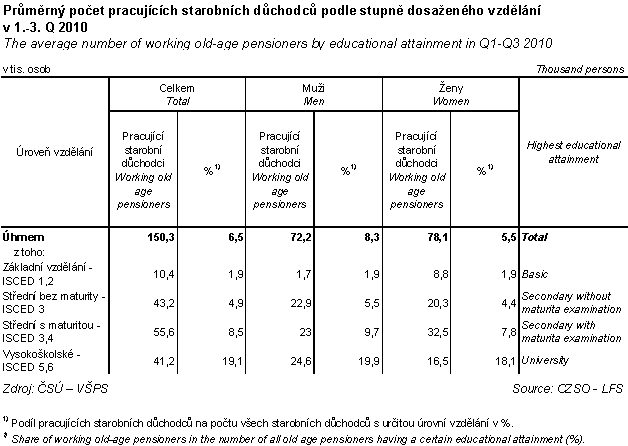
The structure of old-age pensioners’ occupations is markedly different from the branch (CZ-NACE) structure and from types of occupations exercised by other economically active population. This is demonstrated mostly in the share of secondary and tertiary sectors in employment of both the categories of workers. Almost 40% of all persons in productive age, including persons in post-productive age, who have not applied for pension yet, still work in the secondary sector. By contrast, it is only every fifth economically active old-age pensioner who works in this sector. The difference in the shares of working persons in primary sector is small and, moreover, a low number of pensioners work in this sector at all. The dominant sector for employment of old-age pensioners is therefore the tertiary sector of services, which three quarters of all economically active pensioners work in. This share is by 15 percentage points (p.p.) higher than the share in employment in this sector in the main group of working persons.
The absolutely highest number of old-age pensioners works in manufacturing industry, but their share in overall employment in this branch is very low. Old-age pensioners often work in branches of the tertiary sector as in sections of education, professional, scientific and technical activities, human health and social work activities, and in wholesale and retail trade; repair of motor vehicles and motorcycles. Doing so old-age pensioners contribute substantially to employment in several of CZ-NACE sections. If on average for the whole national economy the share of working old-age pensioners was 3.1% of all persons having one (main) job, their representation in numerous sections of tertiary sector was essentially higher. This holds especially for the sections of ‘professional, scientific and technical activities’, ‘arts, entertainment, and recreation’, ‘administrative and support service activities’, and ‘real estate activities’. In aforementioned sections the share of working old-age pensioners in the overall employment in the respective section falls within six and nine per cent.
On the contrary, their share is very low in all CZ-NACE sections of ‘manufacturing‘, ‘construction‘, and in ‘transport and storage‘. Old-age pensioners’ share is also low in certain sections of the tertiary sector as, for instance, in public administration. Persons in younger productive age naturally dominate namely in ‘information and communication’, but also in ‘financial and insurance activities’.
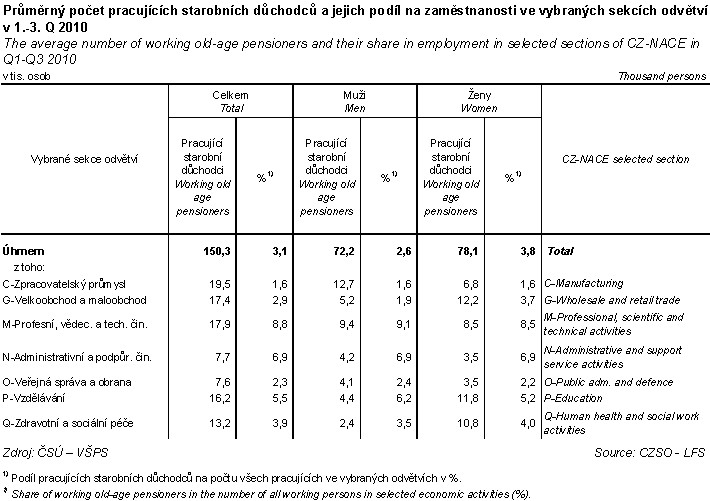
The workplace identification to a CZ-NACE section is closely related to the classification of the occupation exercised. It can be seen from the survey results that 63.5 thousand of old-age pensioners (over 42%) work in highly qualified occupations, included into the major group of ‘professionals’, or into the wide section of ‘technicians and associate professionals’. They also relatively often work in ‘elementary occupations’ (over 14%). At present, not only a number of professionals working in their education specialism can find a good occupation, yet also many of pensioners find jobs out of their education specialism, or out of the occupation they worked in being of productive age. The number of old-age pensioners working at positions of elementary occupations more than twice outnumber the number of all working old-age pensioners having basic education.
Low involvement of old-age pensioners into work in organizations and firms of the production sector documents the fact that their share in the number within the large group of ‘craft and related trade workers‘ and in the group of ‘plant and machine operators and assemblers’ does not attain even mere two per cent of overall employment. These discrepancies are pronounced both in males and females.
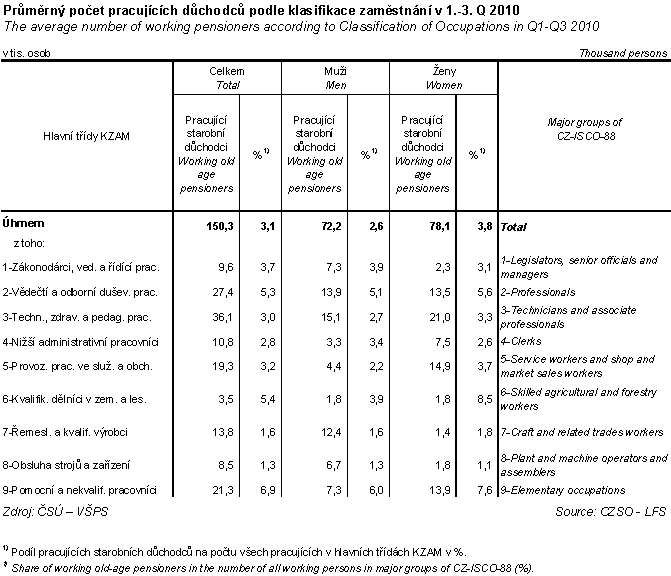
When the group of working old-age pensioners shows great differences against the main group of working persons concerning their educational attainment, occupation, and branch (CZ-NACE) structure, there is also a great difference in the structure of these persons concerning their economic status in work. Although employees also prevail among working old-age pensioners their share is, however, relatively lower – around two thirds. In the main group of working persons this was yet almost 83%. Old-age pensioners often continue in their work activity as entrepreneurs, namely as self-employed without employees. The share of these self-employed without employees represents a quarter of all working persons, who are simultaneously receiving old-age pension. Their share is also higher in the self-employed with employees and, of course, among family workers. If old-age pensioners contribute to the total employment by roughly three per cent, then their representation in the group of the self-employed without employees is near 6%, but in the far largest group of employees they represent sole 2.5%.
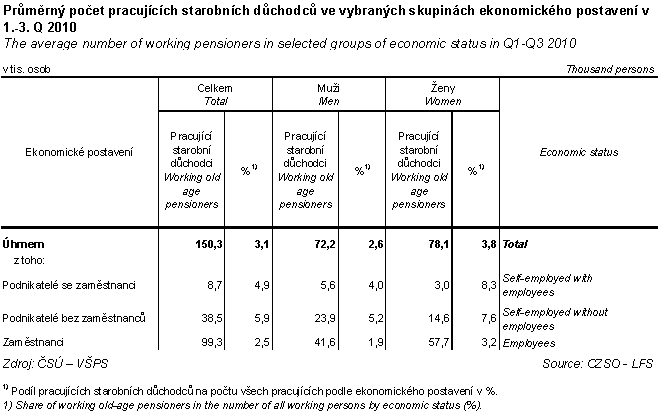
The decisive portion of persons of productive age works full time, which is projected into a low share of working persons in part-time jobs (6.0% of all persons with one or main job). In the case of working pensioners it is different. Virtually every second old-age pensioner works part time (49.2%). In females their share reaches almost 60%, in males it is less than 40%. This difference in between sexes is affected mostly by the fact that males are more frequent working pensioners in the economic status of entrepreneurs. This share of full-time and part-time jobs is balanced in other types of pensions (as disability one, for instance). For the sake of comparison it can be stated that the share of students working part time attains around two thirds.
The structure of working pensioners is specific concerning their type of contract, as well. The number of old-age pensioners in the economic status of employees (71 thousand), who had concluded a contract for definite period, was 2.5 times higher than the number of old-age pensioners-employees having a contract for indefinite period. This situation is completely different from that of other working persons because the share of contracts for definite period in all employees achieves less than nine per cent. Nevertheless, the number of old-age pensioners-employees having a contract for indefinite period (in total over 28 thousand) in some occupations (CZ-ISCO-88) and branches (CZ-NACE) is relatively important. Most of them were working as ‘technicians and associate professionals’ and employees of alike branches.
Differences in worked hours of pensioners and those of other working persons are lower than as the great difference in the share of part-time jobs in both the groups indicates. This is due to the effect of a higher share of self-employed entrepreneurs in the group of working pensioners. A respondent worked, on average during three quarters of this year, 37.7 hours a week within the whole national economy; in the group of working pensioners this time was over 28 hours. In the category of pensioners in early old-age retirement and in the group of pensioners receiving other pension than old-age pension or disability one the average weekly worked time is nearing the average time for all working persons. Especially disability pensioners and those in the large group of pensioners in regular retirement, in which females at the age above sixty years and males above sixty-five years are more significantly represented, work less hours. Males were working longer hours than females in all monitored categories of pension.
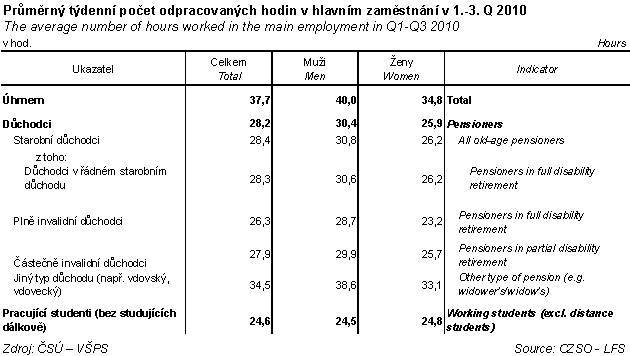
* * *
Pensioners, who are simultaneously working, represent merely a part of the economically active of retirement age. Nevertheless, this way of involvement into employment has beneficial effect on the overall length of active life of population. According to the recent available data of Eurostat the Czech Republic still belongs to countries with a lower age limit for the termination of active occupation. In EU 27 the average age for definitive leave from working life was on average 61.4 years in 2008. In the Czech Republic this was 60.6 years. Just to compare this age was 63.2 in the Netherlands and even 63.8 years in Sweden. The Czech males terminate their active work activities on the labour market at 62.3 years of age, on average, i.e. it is by a quarter of year later than the average of EU 27. The Czech females terminate their activities substantially earlier than in majority of Member States of the European Union (59.0 years in the CR, the EU 27 average is 60.8 years). The definitive leave for retirement is determined mostly by the changing legislation limit for the earning of old-age pension. Besides that, it is, namely in some occupations, affected by possibility of further active work following the earning of old-age pension, without applying for the pension, and, at the same time, the possibility of exercising occupation and receiving pension concurrently.
Contact: Information Services Unit - Headquarters, tel.: +420 274 056 789, email: infoservis@czso.cz










